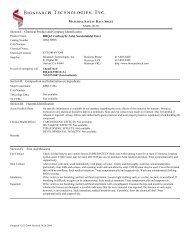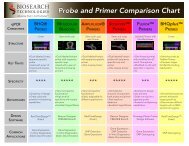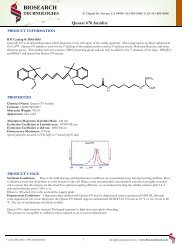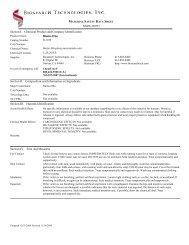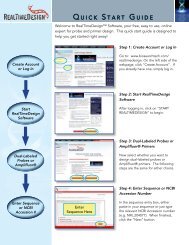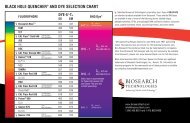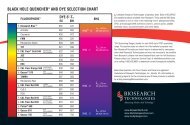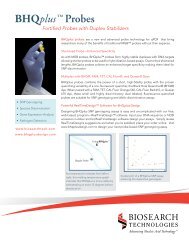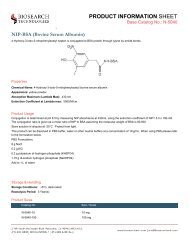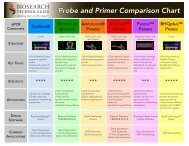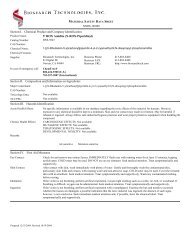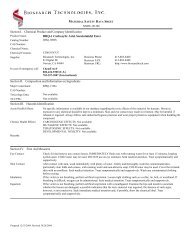Download MSDS for Catalog #BHQ-10 (PDF) - Biosearch ...
Download MSDS for Catalog #BHQ-10 (PDF) - Biosearch ...
Download MSDS for Catalog #BHQ-10 (PDF) - Biosearch ...
You also want an ePaper? Increase the reach of your titles
YUMPU automatically turns print PDFs into web optimized ePapers that Google loves.
MATERIAL SAFETY DATA SHEET<br />
<strong>MSDS</strong>-<strong>10</strong>1293<br />
Section I. Chemical Product and Company Identification<br />
Product Name:<br />
BHQ-<strong>10</strong> Carboxylic Acid<br />
<strong>Catalog</strong> Number: BHQ-<strong>10</strong><br />
CAS Number:<br />
Chemical Name:<br />
Chemical Formula:<br />
Supplier:<br />
In case of emergency call:<br />
Major Constituent:<br />
C23H21N5Na2O8S2<br />
<strong>Biosearch</strong> Technologies, Inc.<br />
81 Digital Dr.<br />
Novato, CA 94949<br />
ChemTrec®<br />
800-424-9300 (U.S.)<br />
703-527-3887 (International)<br />
Section II. Composition and In<strong>for</strong>mation on Ingredients<br />
CAS Number:<br />
Toxicology Data:<br />
TLV/PEL:<br />
BHQ-<strong>10</strong> carboxy<br />
Not available<br />
Not available<br />
Section III. Hazards Identification<br />
Business Phone:<br />
Business FAX:<br />
Business URL:<br />
415-883-8400<br />
415-883-8488<br />
http://www.biosearchtech.com<br />
Acute Health Effects:<br />
Chronic Health Effects:<br />
Hazards:<br />
No specific in<strong>for</strong>mation is available in our database regarding the toxic effects of this material <strong>for</strong> humans. However,<br />
exposure to any chemical should be kept to a minimum. Skin and eye contact may result in irritation. May be harmful if<br />
inhaled or ingested. Always follow safe industrial hygiene practices and wear proper protective equipment when handling<br />
this compound.<br />
CARCINOGENIC EFFECTS: Not available<br />
MUTAGENIC EFFECTS: Not available<br />
TERATOGENIC EFFECTS: Not available<br />
DEVELOPMENTAL TOXICITY: Not available<br />
Section IV. First Aid Measures<br />
Eye Contact:<br />
Skin Contact:<br />
Inhalation:<br />
Ingestion:<br />
Check <strong>for</strong> and remove any contact lenses. IMMEDIATELY flush eyes with running water <strong>for</strong> at least 15 minutes, keeping<br />
eyelids open. COLD water may be used. DO NOT use an eye ointment. Seek medical attention. Treat symptomatically and<br />
supportively.<br />
After contact with skin, wash immediately with plenty of water. Gently and thoroughly wash the contaminated skin,<br />
particularly skin folds and creases, with running water and non-abrasive soap. COLD water may be used. Cover the irritated<br />
skin with an emollient. Seek medical attention. Treat symptomatically and supportively. Wash any contaminated clothing<br />
be<strong>for</strong>e reusing.<br />
If the victim is not breathing, per<strong>for</strong>m artifical respiration. Loosen tight clothing such as a collar, tie, belt, or waistband. If<br />
breathing is difficult, oxygen can be administered. Seek medical attention. Treat symptomatically and supportively.<br />
If the victim is not breathing, per<strong>for</strong>m artifical respiration with a mouthguard. Examine the lips and mouth to ascertain<br />
whether the tissues are damaged, a possible indication that the toxic material was ingested; the absence of such signs,<br />
however, is not conclusive. Seek immediate medical attention and, if possible, show the chemical label. Treat<br />
symptomatically and supportively.<br />
Prepared 4/19/20<strong>10</strong>. Revised 11/16/2004.
<strong>MSDS</strong>-<strong>10</strong>1293 BHQ-<strong>10</strong> Carboxylic Acid<br />
Section V. Fire and Explosion Hazard Data<br />
Flammability:<br />
Auto-Ignition:<br />
Flash Points:<br />
Flammable Limits:<br />
Combustion Products:<br />
Fire Hazards:<br />
Explosion Hazards:<br />
Fire Fighting Media and<br />
Instructions:<br />
May be combustible at high temperature.<br />
Not available<br />
Not available<br />
Not available<br />
Section VI. Accidental Release Measures<br />
Spill Cleanup<br />
Instructions:<br />
Section VII. Handling and Storage<br />
Handling Precautions:<br />
Storage Conditions:<br />
Combustion products include toxic carbon oxides (CO, CO2), nitrogen oxides (NO, NO2)<br />
No specific in<strong>for</strong>mation is available regarding the flammability of this compound in the presence of various materials.<br />
Risk of explosion by mechanical impact: Not available<br />
Risk of explosion by static discharge: Not available<br />
No additional in<strong>for</strong>mation is available regarding the risks of explosion.<br />
SMALL FIRE: Use dry chemicals, CO2, water spray or foam.<br />
LARGE FIRE: Use water spray, fog, or foam. DO NOT use water jet.<br />
In case of a spill and/or leak, always shut off any sources of ignition, ventilate the area, and exercise caution. Use a shovel<br />
to put the material into a convenient waste disposal container. Finish cleaning the spill by rinsing any contaminated surfaces<br />
with copious amounts of water. Consult federal, state, and/or local authorities <strong>for</strong> assistance on disposal.<br />
Keep away from heat and sources of ignition. Store away from incompatible compounds such as oxidizing agents.<br />
-20 °C, dark and dry<br />
Section VIII. Exposure Controls and Personal Protection<br />
Engineering Controls:<br />
Personal Protection:<br />
Use process enclosures, local exhaust ventilation, or other engineering controls to keep airborne levels below recommended<br />
exposure limits. If user operations generate dust, fumes, or mist, use ventilation to keep exposure to airborne contaminants<br />
below the exposure limit.<br />
Splash goggles, lab coat, dust respirator, boots, and thick chemical-resistant gloves. Suggested protective equipment might<br />
not be sufficient. Consult a specialist be<strong>for</strong>e handling this product.<br />
Section IX. Physical and Chemical Properties<br />
Solubility:<br />
Molecular Weight: 605.55<br />
Physical Appearance: dark red solid<br />
Vapor Pressure:<br />
Melting Point:<br />
°C<br />
Boiling Point:<br />
°C at mmHg<br />
Percent Volatile:<br />
Section X. Stability and Reactivity Data<br />
Reactivity:<br />
This material is stable when stored as directed (see section VII).<br />
Section XI. Toxicological In<strong>for</strong>mation<br />
RTECS Number: Not available.<br />
TLV/PEL:<br />
Not available<br />
Routes of Exposure: Eye/skin contact, Ingestion, Inhalation<br />
Toxicity Data:<br />
Not available<br />
Section XII. Ecological In<strong>for</strong>mation<br />
Ecotoxicity:<br />
Not available.<br />
Environmental Fate: Not available.<br />
Section XIII. Disposal Considerations<br />
Waste Disposal:<br />
Recycle to process, if possible. Consult your local or regional authorities. You may be able to dissolve or mix material with<br />
a combustible solvent and burn in a chemical incinerator equipped with an afterburner and scrubber system. Observe all<br />
federal, state, and local regulations when disposing of this substance.<br />
Prepared 4/19/20<strong>10</strong>. Revised 11/16/2004.
<strong>MSDS</strong>-<strong>10</strong>1293 BHQ-<strong>10</strong> Carboxylic Acid<br />
Section XIV. Transport In<strong>for</strong>mation<br />
Transportation:<br />
Section XV. Other Regulatory In<strong>for</strong>mation<br />
Other Regulatory<br />
In<strong>for</strong>mation:<br />
DOT Classification: Not a DOT controlled substance (United States).<br />
PIN Number: Not applicable<br />
Proper Shipping Name: Not applicable<br />
Packing Group (PG): Not applicable<br />
TSCA Chemical Inventory (EPA): This compound is ON the EPA Toxic Substances Control Act (TSCA) inventory list.<br />
WHMIS Classification (Canada): Not available<br />
EINECS Number (EEC): Not available<br />
EEC Risk Statements: Not available<br />
Japanese Regulatory Data: Not available<br />
Section XVI. Other In<strong>for</strong>mation<br />
<strong>Biosearch</strong> Technologies' laboratory chemicals are <strong>for</strong> research purposes only and are not intended <strong>for</strong> use as drugs, food additives, households, or pesticides. The<br />
in<strong>for</strong>mation herein is believed to be correct, but does not claim to be all-inclusive and should only be used as a guide. Neither the above named supplier nor any of its<br />
subsidiaries assumes any liability whatsoever <strong>for</strong> the accuracy or completeness of the in<strong>for</strong>mation contained herein. Final determination of the suitability of any material is<br />
the sole responsibility of the user. All chemical reagents must be handled with the recognition that their chemical, physiological, toxicological, and hazardous properties<br />
have not been fully investigated or determined. All chemical reagents should be handled only by individuals who are familiar with their potential hazards and who have been<br />
fully trained in proper safety, laboratory, and chemical handling procedures. Although certain hazards are described herein, we cannot guarantee that those are the only<br />
hazards that exist. Our <strong>MSDS</strong> sheets are based only on data available at the time of shipping and are subject to change without notice as new in<strong>for</strong>mation is obtained. Avoid<br />
long storage periods as the product is subject to degradation with age and may become more dangerous or hazardous. It is the responsibility of the user to request updated<br />
<strong>MSDS</strong> sheets <strong>for</strong> products that are stored <strong>for</strong> extended periods. Disposal of unused product must be undertaken by qualified personnel who are knowledgeable in all<br />
applicable regulations and follow all pertinent safety precautions including the use of appropriate protective equipment (e.g. protective goggles, protective clothing,<br />
breathing equipment, facial mask, fume hood). For proper handling and disposal, always comply with federal, state, and local regulations.<br />
Prepared 4/19/20<strong>10</strong>. Revised 11/16/2004.




